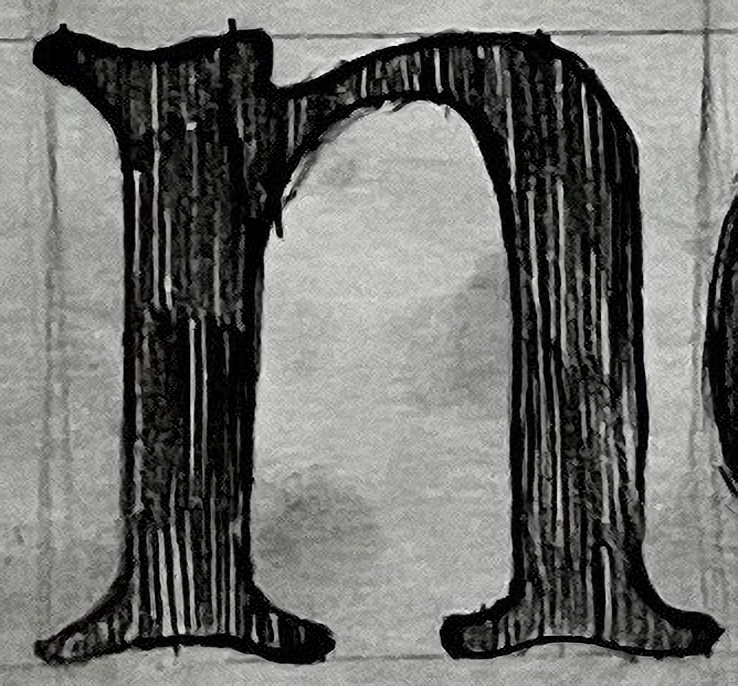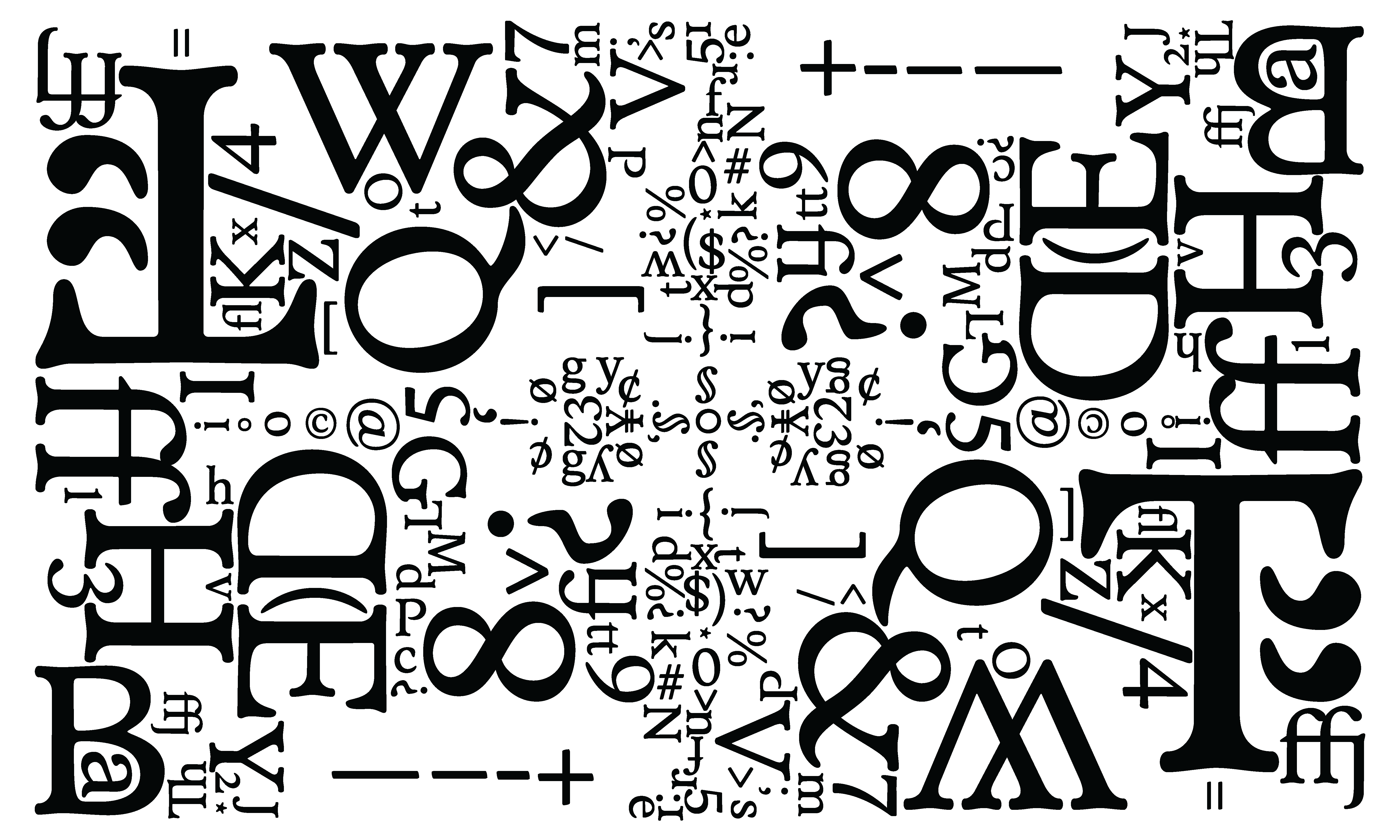Saknussemm!
Verne Roman is...
a text typeface drawing typographic inspirations from the new and old alike. It was crafted with the intent of being set within the classic novel Journey to the Center of the Earth by renowned French novelist Jules Verne, the typeface’s namesake. The text typeface was directly shaped by the book’s balance of Old World fascinations and scientific intrigue. The genre of subterranean fiction existed well before Jules Verne, but the book’s extensive appliance of Victorian science as a narrative tool. The typefaces that were used to draw direct visual inspirations from would be a balance of the new, the old, and the scientific.
Journey to the Centre of the Earth is one of the oldest science fiction classics. It’s a story set in the 1860s about a journey to a prehistoric world, so it felt natural to pick a typeface from or preceding that time. The classic old style serifs come to mind, and Garamond is considered to be one of the oldest of these typefaces being cut in Paris in 1535 by Claude Garamond. Jules Verne was born in France and became a historically important author there, making Garamond even more suitable a choice. Not to mention Garamond being a top choice for setting type throughout history. Its iconic serif quality is the inspiration for countless preceding typefaces, it’s definitely a typeface that can embody the breakthrough that Journey to the Center of the Earth was as a science fiction classic. ITC Galliard was designed by Matthew Carter, and was based on the sixteenth-century type by French type designer Robert Granjon. The typeface is named after a very lively Renaissance dance, and it can be seen in the energetic angles of the letterforms. Granjon’s work in italic letterforms actually became a model for the modern Garamond Italic, not to mention he was Claude Garamond’s assistant. Galliard itself was designed in 1978, a much later time,
but I believe that Journey to the Center of the Earth has a very modern identity. The genre of subterranean fiction existed well before Jules Verne, but the book is a literary breakthrough in its extensive research into Victorian science as a storytelling tool. That’s why I believe newer serif typefaces, especially ones that are influenced by old style typography, can embody Journey to the Center of the Earth as the progressive science fiction that it is. Plantin was a choice inspired by the scientific intrigue in Jules Verne’s novel. So much of the book goes into great scientific detail to build the world that it exists in, and I believe Plantin would be a great choice for the book to be set in. For starters, Plantin was the inspiration for Times New Roman, which has been used in literally countless scientific journals. This font was also based on the work of Granjon, so Plantin which was created in 1913, acts as an intermediary between the old ways and its modern applications—much like how the novel bridged the gap between classic literature and sci-fi. As the look and feel of Verne Roman emerged, I saw its appliance in a realm between science and fantasy. I could see it being used within formal scientific documentation and
high fantasy literature alike. As my first official typeface, I am excited by the possibilities of how this typeface can be put to use. Journey to the Centre of the Earth being as old as it is, it was a natural choice to pick a typeface that preceded the story’s time. Garamond, one of the oldest and most timeless fonts there is, was created by French typographer Claude Garamond and is known for its classic forms and unique rounds. ITC Galliard is a typeface designed by Matthew Carter in 1978, and was based on the sixteenth-century type by French typographer Robert Granjon, who so happened to be Claude Garamond’s assistant. How ITC Galliard was tailored from such classic typography in a relatively recent era embodies much of what I believe the novel to be—a scientifically modern spin on a classic literary genre for Verne’s time. Plantin was an appropriate typeface for what it drew inspiration from and what it became an inspiration for. Plantin spoke to the scientific aspect of my typeface’s inspiration, as its original creation in 1913 was essential in the modeling of Times New Roman—a font used for countless documents of scientific record. In a three-way coincidence, Plantin was also inspired Granjon.
It’s not what is upon this island, but what is underneath that interests me.
1535
1978
On the 24th of May, 1863, my uncle, Professor Liedenbrock, rushed into his little house, No. 19 Konigstrasse, one of the oldest streets in the oldest portion of the city of Hamburg. Martha must have concluded that she was very much behindhand, for the dinner had only just been put into the oven. “Well, now,” said I to myself, “if that most impatient of men is hungry, what a great disturbance he will make!” “M. Liedenbrock so soon!” cried poor Martha in great alarm, half opening the dining-room door. “Yes, Martha; but very likely the dinner is not half cooked, for it is not two yet. Saint Michael’s clock has only just struck half-past one.” “Then why has the master come home so soon?” “Perhaps he will tell us that himself.” “Here he is, Monsieur Axel; I will run and hide myself while you argue with him.” And Martha retreated in safety into her own dominions. I was left alone. But how was it possible for a man of my undecided turn of mind to argue successfully with so irascible a person as the Professor? With this persuasion I was hurrying away to my own little retreat upstairs, when the street door creaked upon its hinges; heavy feet made the whole flight of stairs to shake; and the master of the house, passing rapidly through the dining-room, threw himself in haste into his own sanctum. But on his rapid way he had found time to fling his hazel...


The affluent fjord cliffjumper
affixed puffed floral figures.
But at that moment my attention was drawn to an unexpected sight. At a distance of five hundred paces, at the turn of a high promontory, appeared a high, tufted, dense forest. It was composed of trees of moderate height,
formed like umbrellas, with exact geometrical outlines.
The currents of wind seemed to have had no effect upon their shape, and in the midst of the windy blasts they stood unmoved and firm, just like a clump of petrified cedars.
I hastened forward. I could not give any name to these singular creations. Were they some of the two hundred thousand species of vegetables known hitherto, and did they claim a place of their own in the lacustrine flora? No; when we arrived under their shade my surprise turned into admiration. There stood before me productions of earth, but of gigantic stature, which my uncle immediately named.
“It is only a forest of mushrooms,” said he. And he was right. Imagine the large development attained by these plants, which prefer a warm, moist climate. I knew that the Lycopodon Giganteum attains, according to Bulliard,
a circumference of eight or nine feet; but here were pale
mushrooms, thirty to forty feet high, and crowned with
a cap of equal diameter. There they stood in thousands.
No light could penetrate between their huge cones, and complete darkness reigned beneath those giants; they formed settlements of domes placed in close array like the round, thatched roofs of a central African city. Yet
I wanted to penetrate farther underneath, though a chill fell upon me as soon as I came under those cellular vaults. For half an hour we wandered from side to side in the damp shades, and it was a comfortable and pleasant change to arrive once more upon the sea shore. But the subterranean vegetation was not confined to these fungi. Farther on rose groups of tall trees of colourless foliage and easy to recognise. They were lowly shrubs of earth, here attaining gigantic size; lycopodiums, a hundred feet high; the huge sigillaria, found in our coal mines; tree ferns, as tall as our fir-trees in northern latitudes; lepidodendra, with cylindrical forked stems, terminated by long leaves, and bristling with rough hairs like those of the cactus. “Wonderful, magnificent, splendid!” cried
my uncle. “Here is the entire flora of the second period of the world—the transition period. These, humble garden plants with us, were tall trees in the early ages. Look, Axel, and admire it all. Never had botanist such a feast as this!” “You are right, my uncle. Providence seems to have pre- served in this immense conservatory the antediluvian plants which the wisdom of philosophers has so sagaciously put together again.” “It is a conservatory, Axel; but is it not also a menagerie?” “Surely not a menagerie!” “Yes; no doubt of it. Look at that dust under your feet; see the bones scattered on the ground.” “So there are!” I cried; “bones of extinct animals.” I had rushed upon these remains, formed of indestructible phosphates of lime, and without hesitation I named these monstrous bones, which lay scattered about like decayed trunks of trees. “Here is the lower jaw of a mastodon,”* I said. “These are the molar teeth of the deinotherium; this femur must have belonged to the greatest of those beasts, the megatherium. It certainly is a menagerie, for these remains were not brought here by
a deluge. The animals to which they belonged roamed on...
antediluvian, basaltic, cephalaspidae, devonian, echinodermata, flora, grotto, hepaticas, ichthyosaurus, Johannaeum, kauris, lignite, megatherium, nitrogen, oscillations, pterichthydes, quartz, reservoir, sedimentary, tempest-tossed, undulated, volcanic, whirlwind, Xenophon, yews, zoophytes
Suddenly I halted. I drew back my uncle. The diffused light revealed the smallest object in the dense and distant thickets. I had thought I saw—no! I did see, with my own eyes, vast colossal forms moving amongst the trees. They were gigantic animals; it was a herd of mast- odons—not fossil remains, but living and resembling those the bones of which were found in the marshes of Ohio in 1801. I saw those huge elephants whose long, flexible trunks were grouting and turning up the soil under the trees like a legion of serpents. I could hear the crashing noise of their long ivory tusks boring into the old decaying trunks. The boughs cracked, and the leaves torn away by cartloads went down the cavernous throats of the vast brutes. So, then, the dream in which I had had a vision of the prehistoric world, of the tertiary and
My uncle Liedenbrock ventured to penetrate under this colossal grove. I followed him, not without fear. Since nature had here provided vegetable nourishment, why should not the terrible mammals be there too? I perceived in the broad clearings left by fallen trees, decayed with age, leguminose plants, acerineae, rubiceae and many other eat- able shrubs, dear to ruminant animals at every period. Then
I observed, mingled together in confusion, trees of countries far apart on the surface of the globe. The oak and the palm were growing side by side, the Australian eucalyptus leaned against the Norwegian pine, the birch-tree of the north mingled its foliage with New Zealand kauris. It was enough to distract the most ingenious classifier of terrestrial botany.
post-tertiary periods, was now realised. And there we were alone, in the bowels of the earth, at the mercy of its wild inhabitants! My uncle was gazing with intense and eager interest. “Come on!” said he, seizing my arm. “Forward! forward!” “No, I will not!” I cried. “We have no firearms. What could we do in the midst of a herd of these four-footed giants? Come away, uncle—come! No human being may with safety dare the anger of these monstrous beasts.” “No human creature?” replied my uncle in a lower voice. “You are wrong, Axel. Look, look down there! I fancy I see a living creature similar to ourselves: it is a man!” I looked, shaking my head incredulously. But though at first I was unbelieving
I had to yield to the evidence of my senses. In fact, at a distance of a quarter of a mile, leaning against the trunk
of a gigantic kauri, stood a human being, the Proteus of those subterranean regions, a new son of Neptune, watching this countless herd of mastodons. Immanis pecoris custos, immanior ipse. Yes, truly, huger still himself. It was no longer a fossil being like him whose dried remains we had easily lifted up in the field of bones; it was a giant, able to control those monsters. In stature he was at least twelve feet high. His head, huge and unshapely as a buffalo’s, was half hidden in the thick and tangled growth of his unkempt hair. It most re- sembled the mane of the primitive elephant. In his hand he wielded with ease an enormous bough, a staff worthy of this shepherd of the geologic period. We stood petrified and speechless with amazement. But he might see us! We must fly! “Come, do come!” I said to my uncle,
who for once allowed himself to be persuaded. In another quarter of an hour our nimble heels had carried us beyond the reach of this horrible monster. And yet, now that I can reflect quietly, now that my spirit has grown calm again, now that months have slipped by since this strange and supernatural meeting, what am
I to think? what am I to believe? I must conclude that it was impossible that our senses had been deceived, that our eyes did not see what we supposed they saw. No human being lives in this subterranean world; no generation of men dwells in those inferior caverns of the globe, unknown to and unconnected with the inhabitants of its surface. It is absurd to believe it! I had rather admit that it may have been some animal whose structure resembled the human, some ape or baboon of
the early geological ages, some protopitheca, or some mesopitheca, some early or middle ape like that discovered by Mr. Lartet in the bone cave of Sansau. But this creature surpassed in stature all the measurements known in modern palaeontology. But that a man, a living man, and therefore whole generations doubtless besides, should be buried there in the bowels of the earth, is impossible. However, we had left behind us the luminous forest, dumb with astonishment, overwhelmed and struck down with a terror which amounted to stupefaction. We kept running on for fear the horrible monster might be on our track. It was a flight, a fall, like that fearful pulling and dragging which is peculiar to nightmare. Instinctively we got back to the Liedenbrock sea, and I cannot say into what vagaries...
Who would have ever imagined, under this terrestrial crust, an ocean with ebbing and flowing tides, with winds and storms?
Forty-eight hours were left before our departure; to my great regret I had to employ them in preparations; for all our ingenuity was required to pack every article to the best advantage; instruments here, arms there, tools in this package, provisions in that: four sets of packages in all. The instruments were: 1. An Eigel’s centigrade thermometer, graduated up to 135 degrees (286 degrees Fahr.), which seemed too much or too little.
He stood with arms crossed, perfectly unmoved by my uncle’s incessant gesticulations. A negative was expressed by a slow movement of the head from left to right, an affirmative by a slight bend, so slight that his long hair scarcely moved. He carried economy of motion even to parsimony. Certainly I should never have dreamt in looking at this man that he was a hunter; he did not look likely to frighten his game, nor did he seem as if he would even get near it. But the mystery was explained when M. Fridrikssen informed me that this tranquil personage was only a hunter of the eider duck, whose under plumage constitutes the chief wealth of the island. This is the celebrated eider down, and it requires no great rapidity of movement to get it. Early in summer the female, a very pretty bird, goes to build her nest among the rocks of the fiords with which the coast is fringed. After building the nest she feathers it with down plucked from her own breast. Immediately the hunter, or rather the trader, comes and robs the nest, and the female recommences her work. This goes on as long as she has any down left. When she has stripped herself bare the male takes his turn to pluck himself. But as the coarse and hard plumage of the male has no commercial value, the hunter does not take the trouble to rob the nest of this; the female therefore lays her eggs in the spoils of her mate, the young are hatched, and next year the harvest begins again. Now, as the eider duck does not select steep cliffs for her nest, but rather the smooth terraced rocks which slope to the sea, the Icelandic hunter might exercise his calling without any inconvenient exertion. He was a farmer who was not obliged either to sow or reap his harvest, but merely to gather it in. This grave, phlegmatic, and silent individual was called Hans Bjelke; and he came recommended by M. Fridrikssen. He was our future guide. His manners were a singular contrast with my uncle’s. Nevertheless, they soon came to understand each other. Neither looked at the amount of the payment: the one was ready to accept whatever was offered; the other was ready to give whatever was demanded. Never was bargain more readily concluded.

